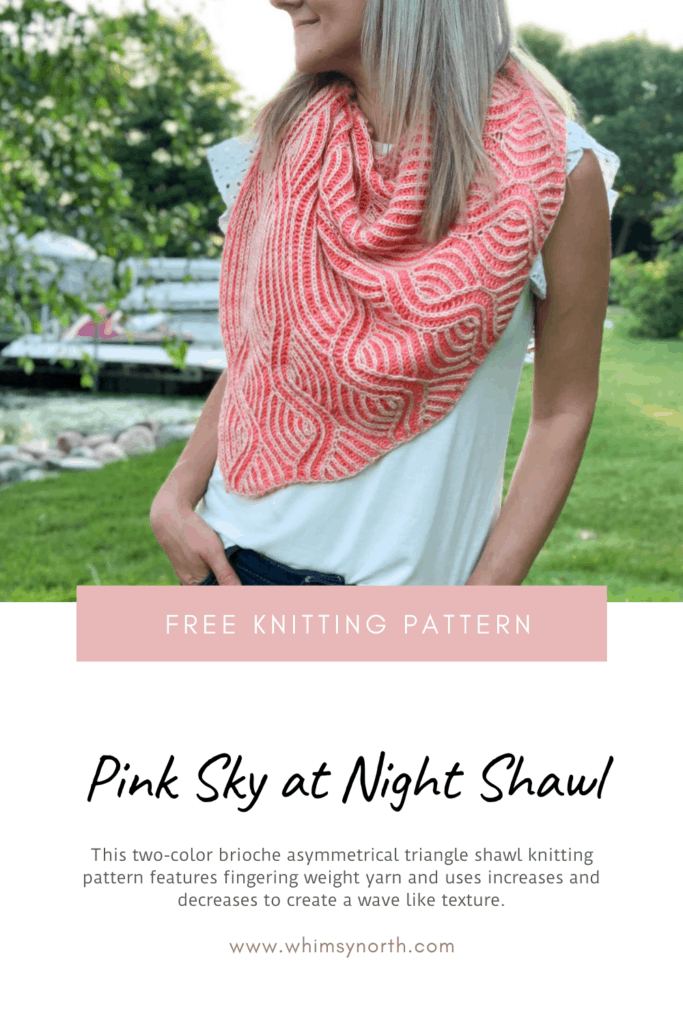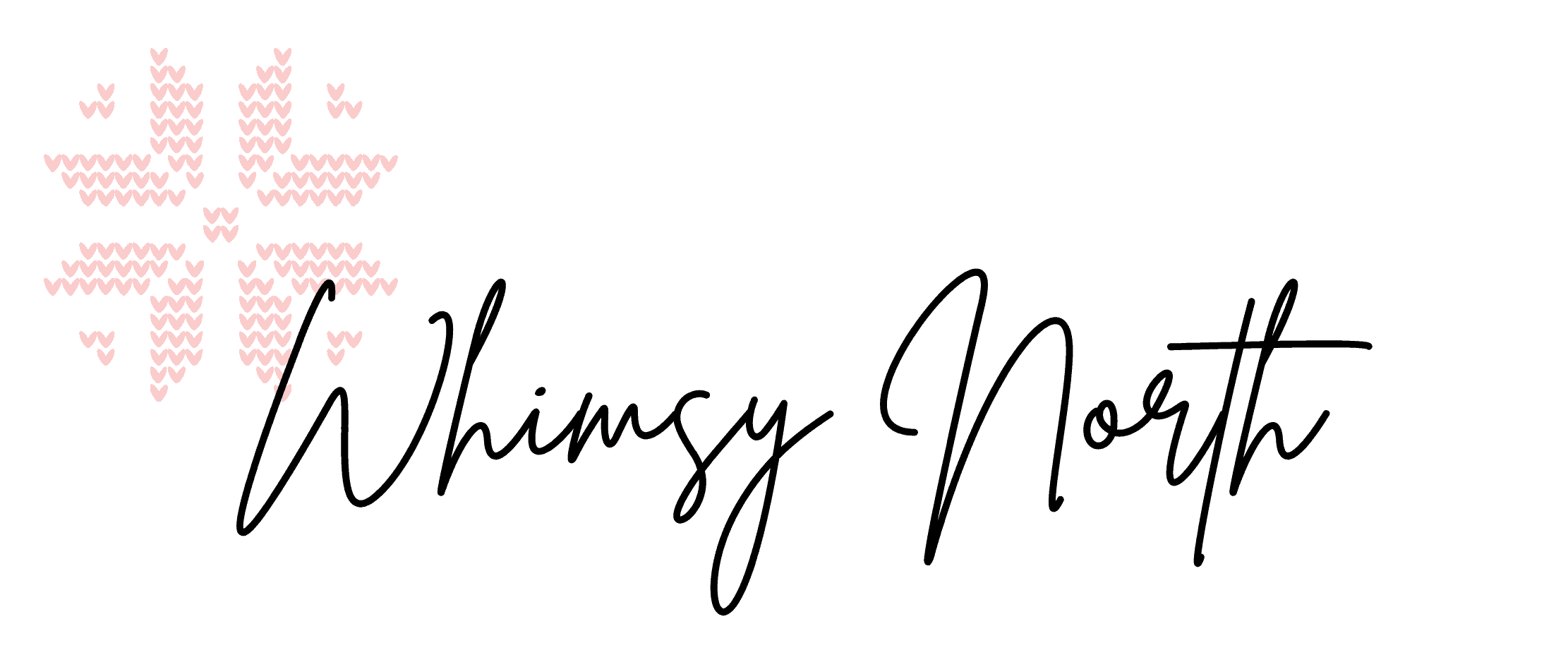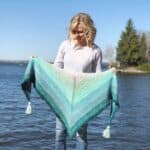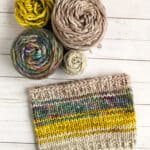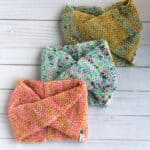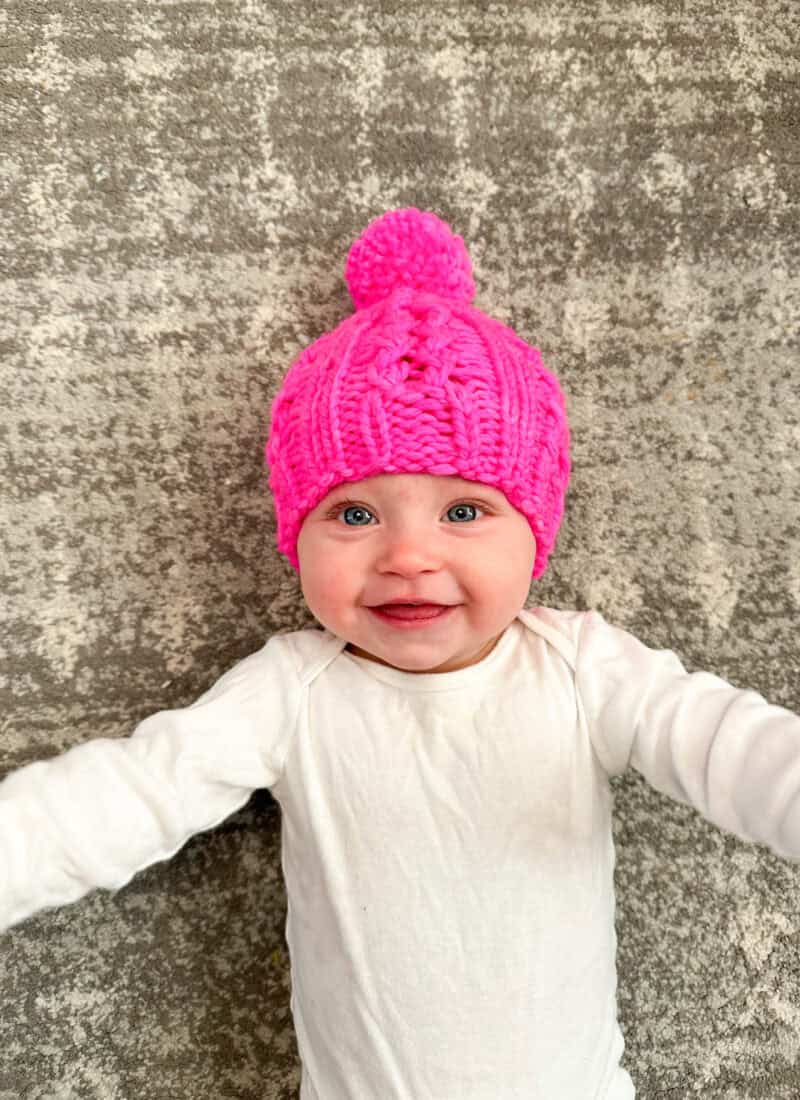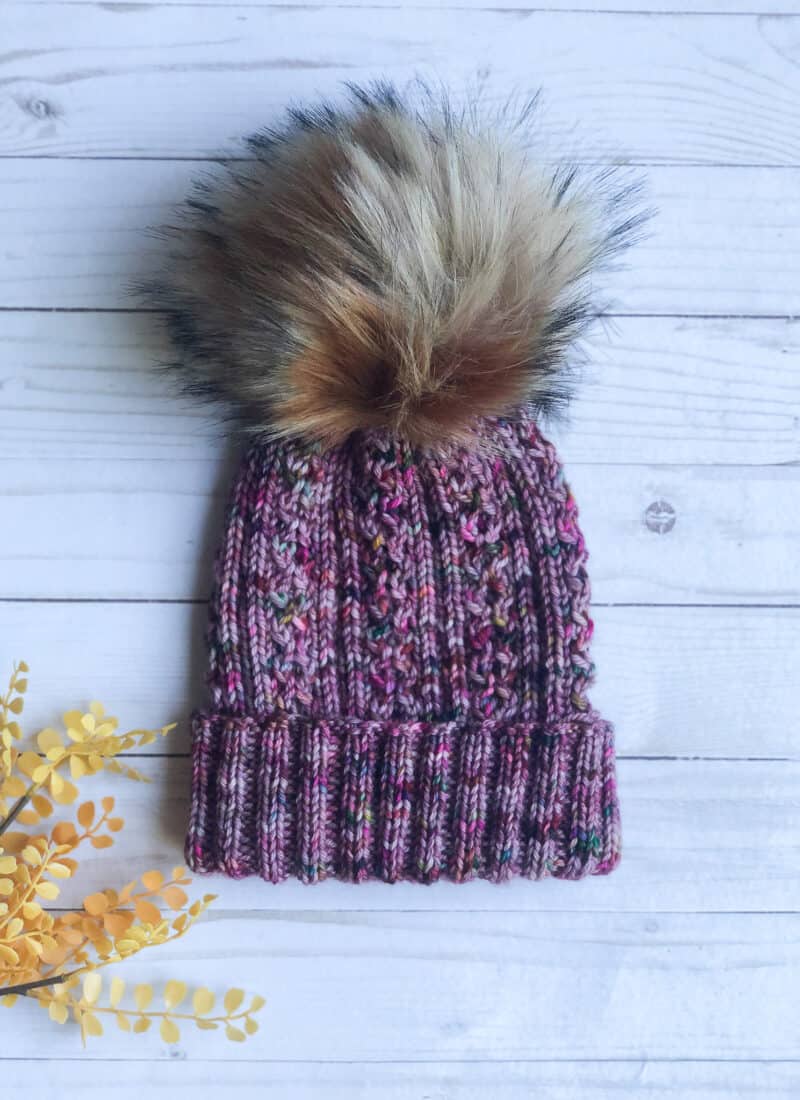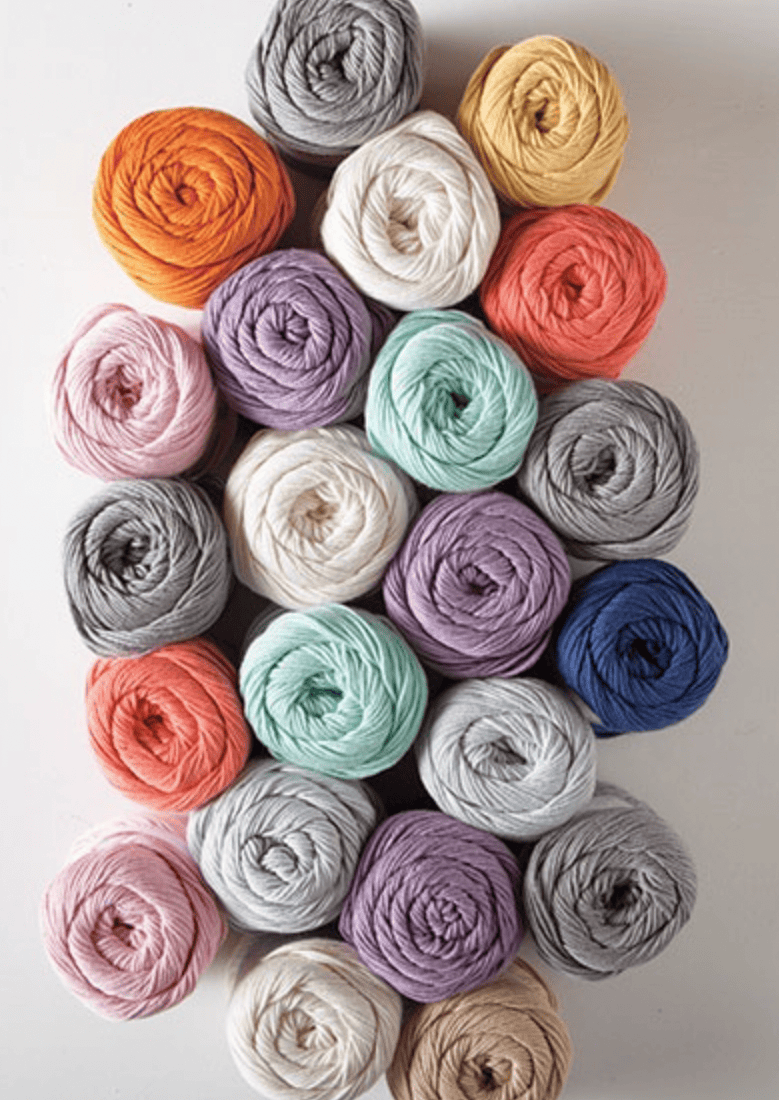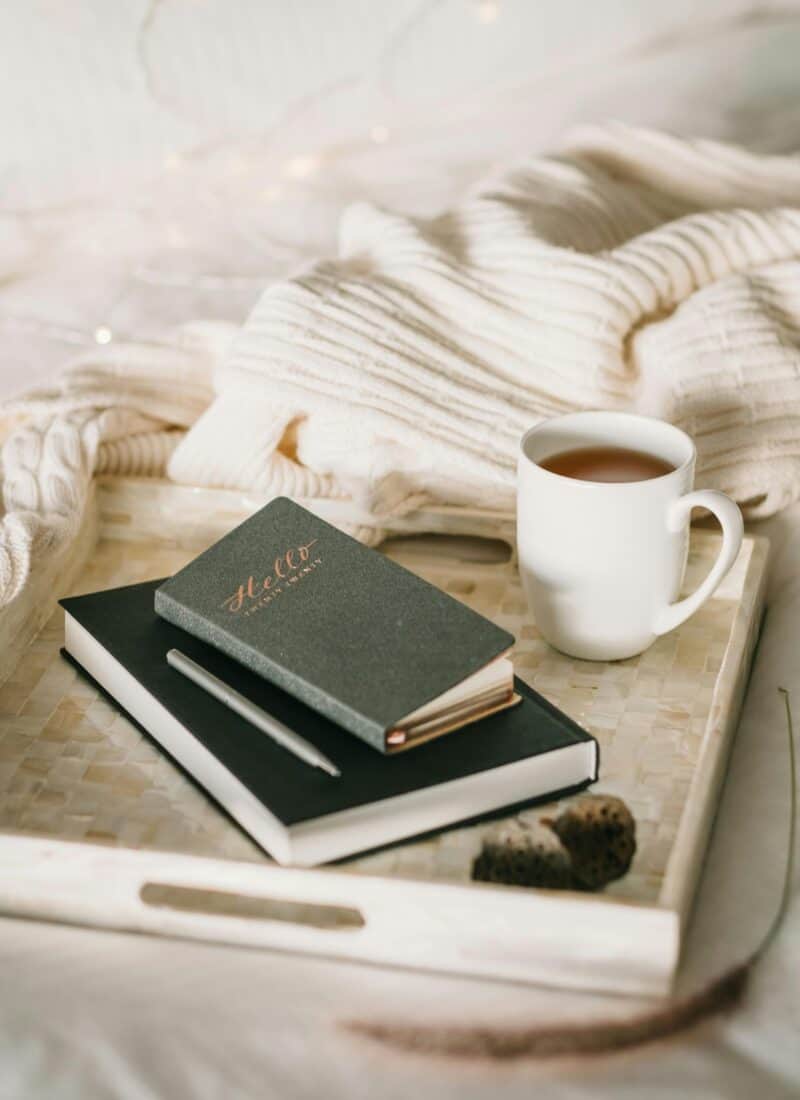An asymmetrical triangle shawl my – Pink Sky at Night Shawl – is a free brioche shawl knitting pattern here on the blog! Read through my design process, why I swear by lifelines and my suggestions for yarns. Or scroll down for the free pattern.
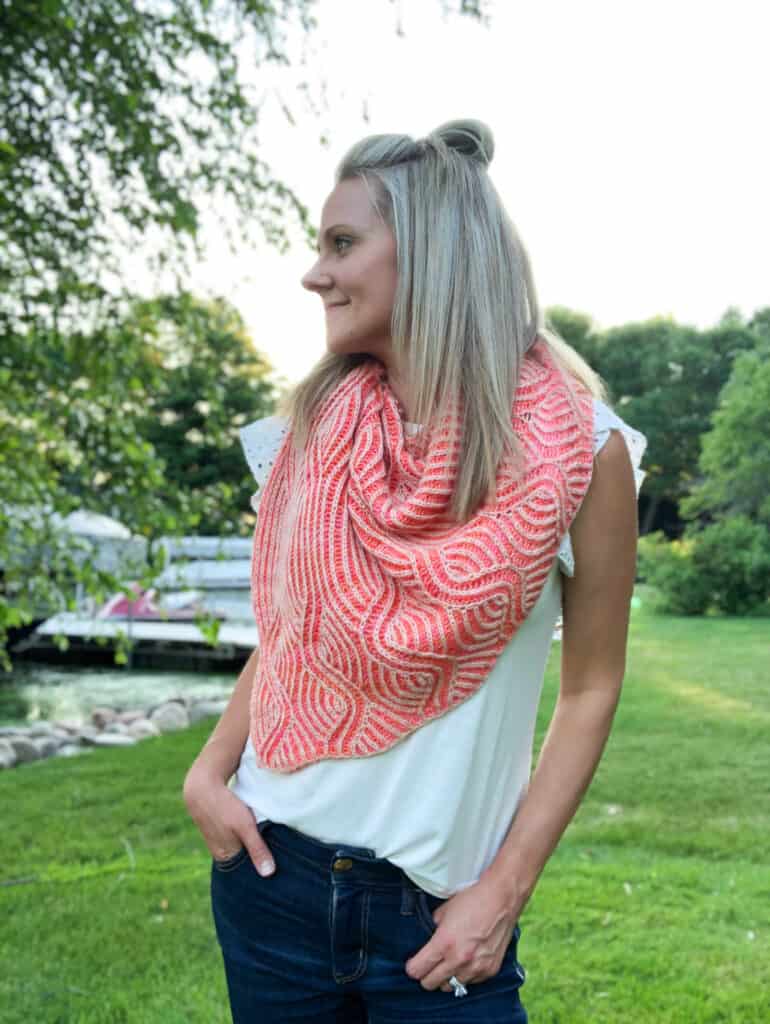
This post may contain affiliate links. In the event of a sale, I get rewarded a small commission, at no extra cost for you. These funds help me keep my blog up and running to provide you with great content and free patterns so thank you!
Brioche Knitting
If you haven’t already I highly recommend you check-out my brioche knitting section on the blog. In it, I go over How to Knit Two-Color Brioche, as well as, Increasing and Decreasing in Two-Color Brioche Knitting.
Both of these posts give you the foundational knowledge to creating this shawl. They feature step by step written instructions and also full video tutorials.
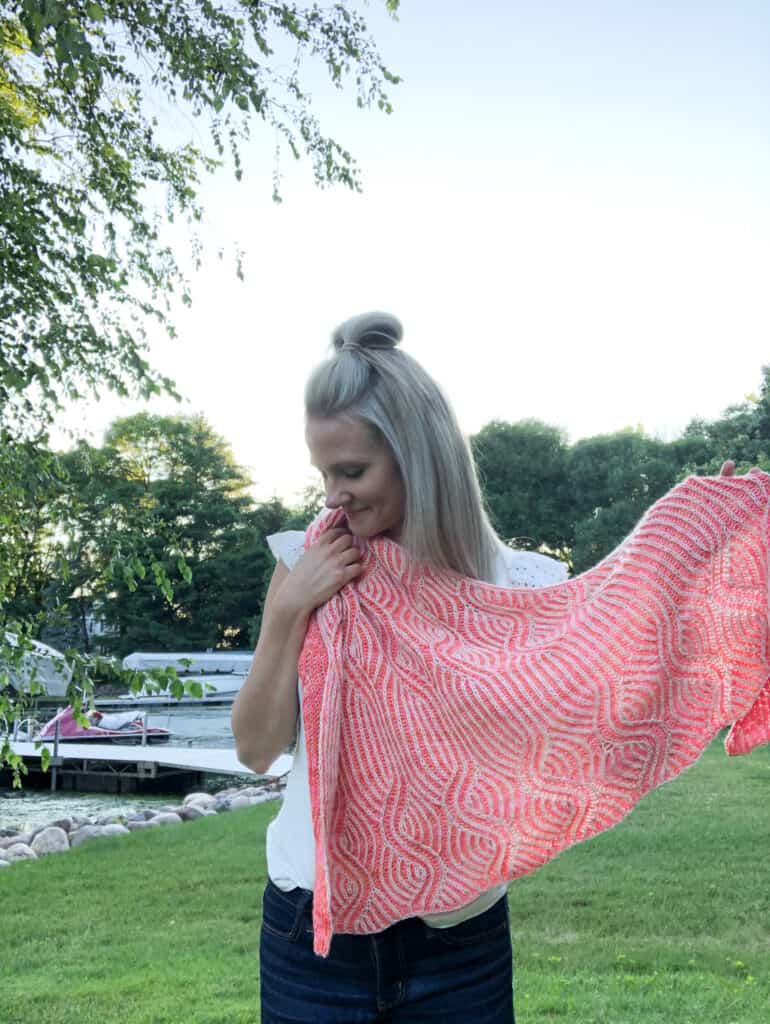
Choosing your yarn
This shawl calls for about 370 yards each of two different color fingering weight yarns. When it comes to two-color brioche, I highly recommend choosing a light color yarn and a dark color yarn.
Most hand-dyed fingering weight yarns come in around 400-437 yards per skein. Therefore, you will most likely need only one skein per color. I chose to use two different hand-dyed yarns from some of my favorite independent yarn dyers. The light color is from Woolberry Fiber Co and the dark is from Hedgehog Fibres.
For more budget friendly option I love Knit Picks – Stroll Tonal. It’s Merino Wool and so super soft and comes with 462 yards so plenty to knit the entire shawl with one skein. It’s about half the price of a typical hand-dyed independent dyer skein of yarn and so makes a great option for this shawl.
I also love Knit Picks – Hawthorne Kettle Dyed as the color options are fantastic. I find it to be slightly less soft as the Stroll Tonal since that is a merino wool but just as pretty.
Sign up for my newsletter to be notified every time I release a new pattern to the blog!
What is a lifeline and why should you use one?
You can see my lifelines in the photo below. Essentially, it’s when you thread a piece of yarn through your live stitches on the needle and leave it there in case you make a mistake down the road.
Brioche is challenging to fix. Especially when you have increases and decreases going on. I’m typically a fudge it and fix it as best I can type of knitter. I’m no perfectionist that’s for sure. However, when it comes to brioche mistakes are more glaringly obvious and therefore I take the time to fix them. Since fixing a mistake is difficult for me, I many times end up ripping my knitting back to a lifeline.
This process happened many times while designing this shawl. I’m a mom and distracted. All it takes is one missed stitch and the entire waves design will not look correct. When I noticed a miss stitch I would simply take out my needles and “frog” my work back to a lifeline. The stitches would be live and ready to be placed on my needle.
When inserting a lifeline, I liked to do it after every section. This way, I was only ripping back around 20 rows of knitting instead of starting all over again.
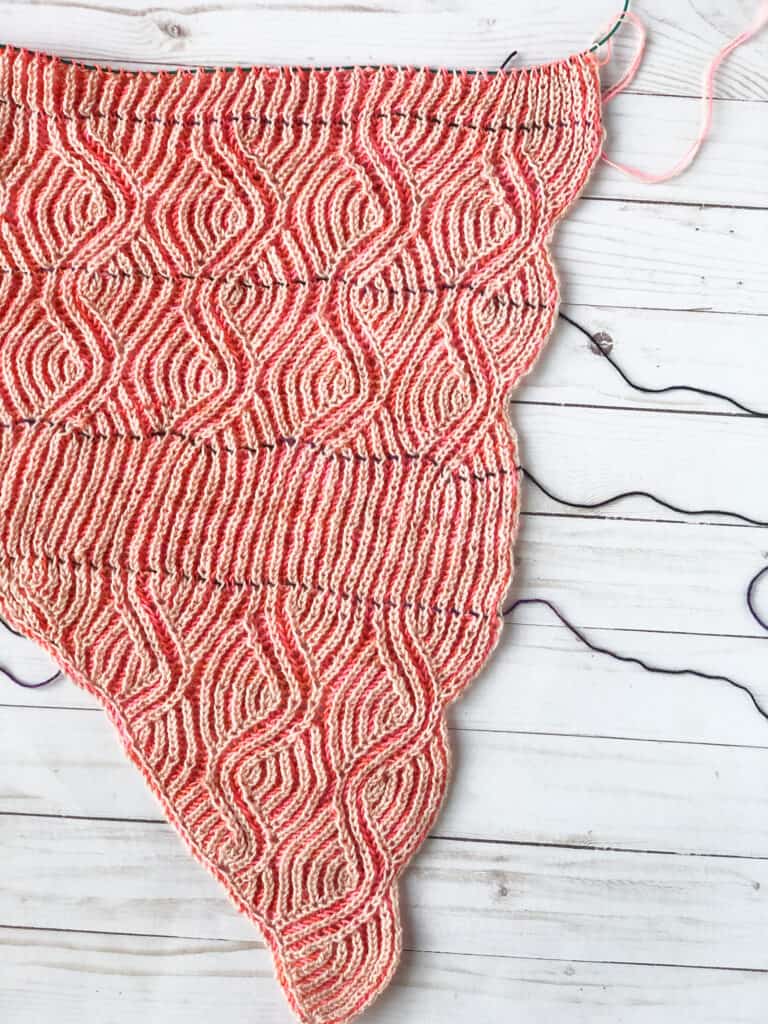
Pink Sky at Night – Free Brioche Shawl Knitting Pattern
- Purchase the ad-free, large print PDF pattern here.
- Add this to your Ravelry queue here.
- Pin it to Pinterest here.
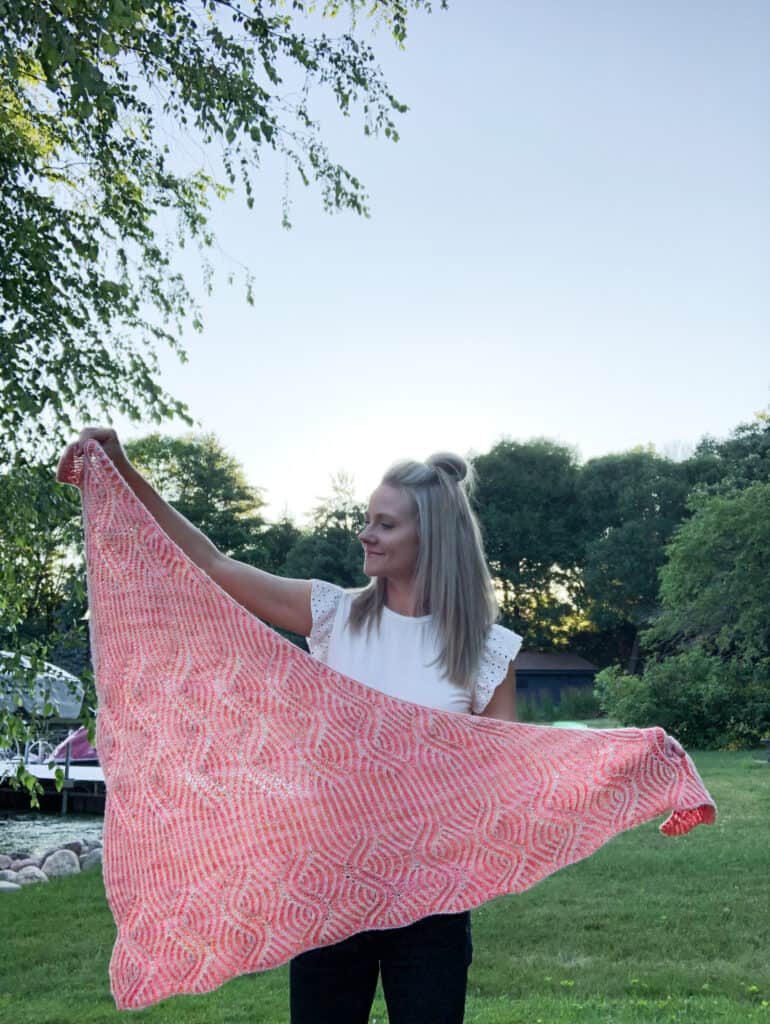
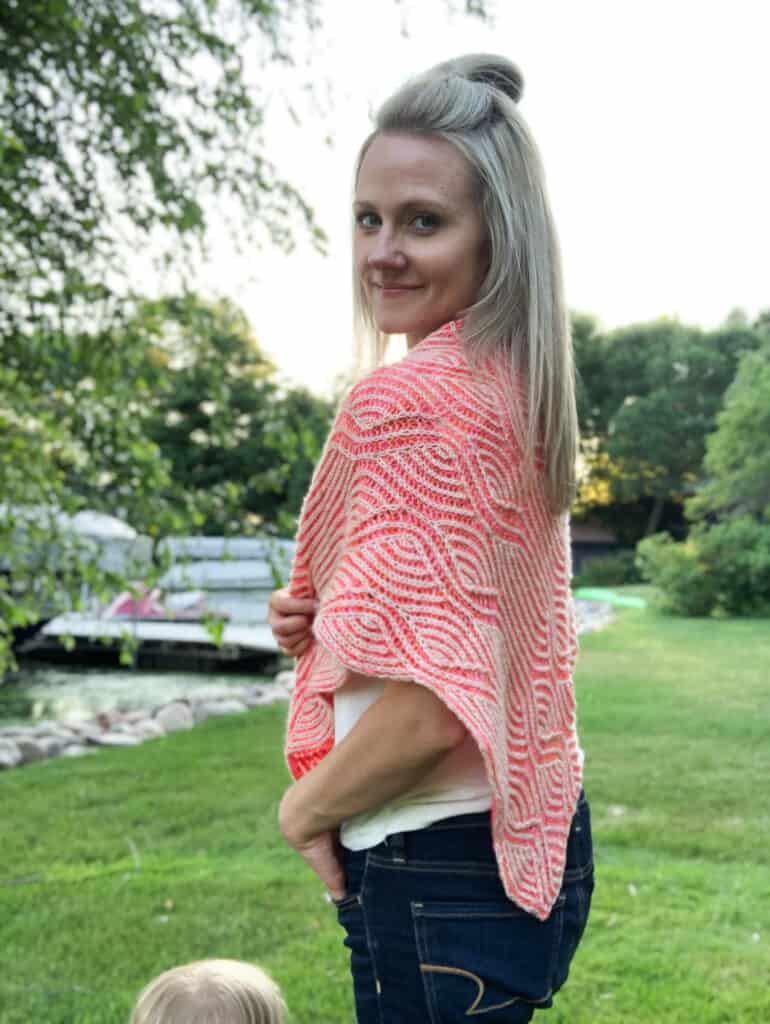
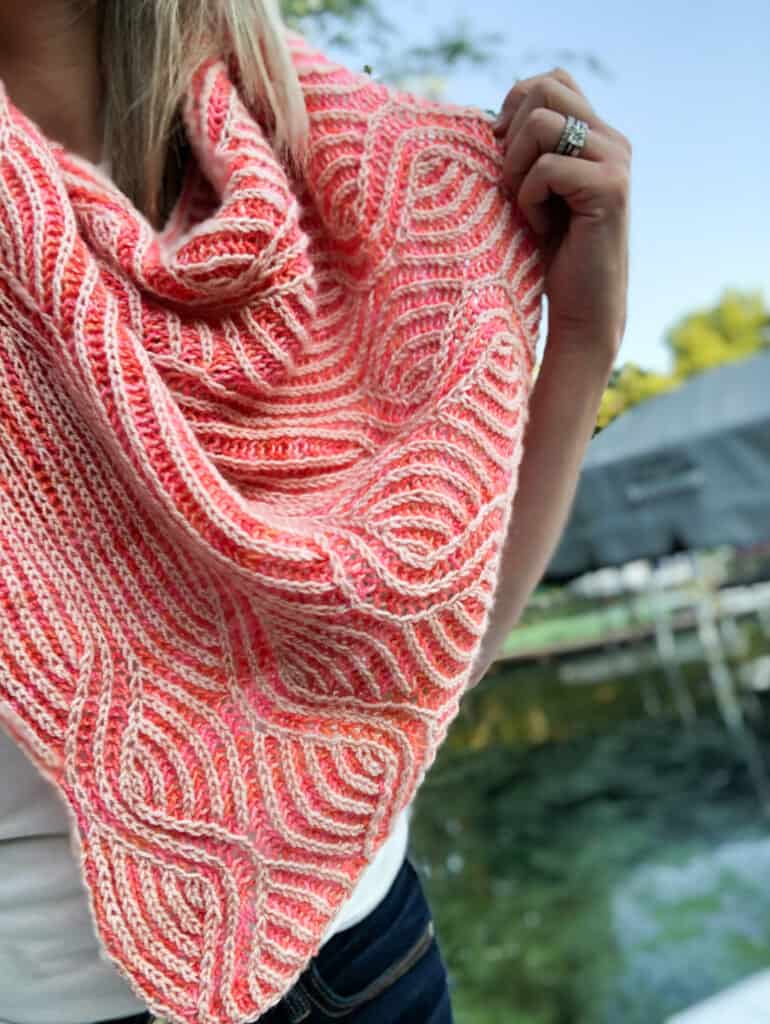
Construction + Notes:
This asymmetrical triangle shawl features a two-color brioche wave pattern broken up by simple straight two-color brioche. My mom is a sailor and growing up when she saw a pink sky in the evening she would say “pink sky at night, sailors delight.” This shawl reminds me of sailing the winds and waves mixed with periods of calm.
Main Side / Contrasting Side
On all MS CC rows after an MS MC increase row, process all of the yo in the brkyobrk as a “p1” rather than a “brp1”. Therefore, any previous brkyobrk sts will read as sl1yo, p1, sl1yo. See video tutorials for help.
Stitch Counts
On some increase rows, you may end the row in pattern with a 2 st decrease where there aren’t enough sts to complete the decrease before you are supposed to brkyobrk [inc]. In this case, skip the decrease and always complete the brkyobrk on the increase row. You may have some rows with extra increases or decreases based on the way the pattern lays out. Instead of tracking each row stitch counts look at the final section counts instead.
Supplies:
yarn
- Fingering / Sock weight yarn
- Main Color (MC): 370 yd / 338 m
- Contrast Color (CC): 370 yd / 338
Needles
US 4/ 3.5mm: 40″ / 102cm long circular needle. (These are the needles I use! I love that I can easily switch between needles sizes if I need to size up or down to get gauge)
notions
finished measurements
One Size: Wingspan 53″ / 135 cm
Depth 23″ / 58 cm
gauge
21 sts & 24 rows = 4”/10 cm
Measured in two-color brioche stitch after blocking.
(here is a gauge ruler you can use to check before you start knitting.)
PIN IT!
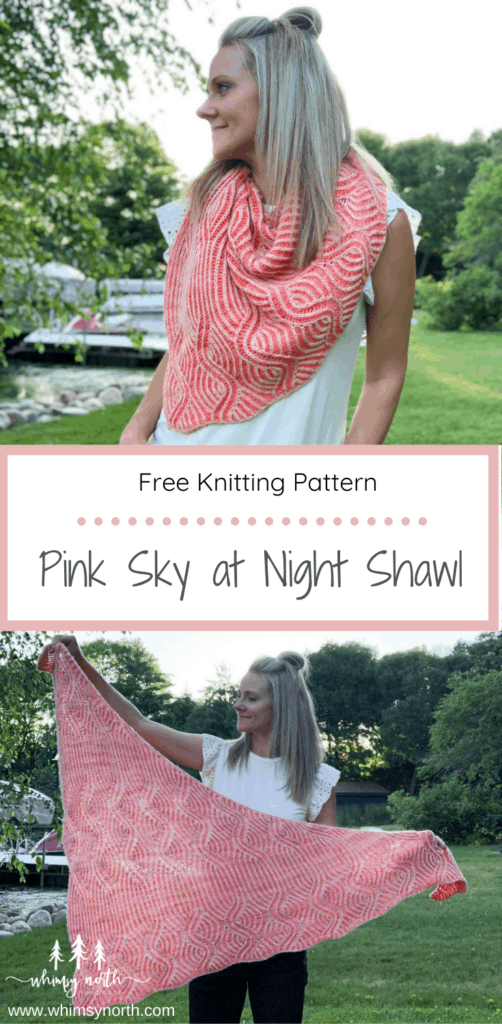
Glossary:
{} = Repeat
BO = Bind off
brk = Brioche knit (bark) – knit the st that was slipped in the previous row together with its yarn over
brkyobrk = (2 st increase) – brk1, leaving st on LH needle, yo, then brk1 into the same st.
brp = Brioche purl (burp) – purl the st that was slipped in the previous row together with its yarn over
brLsl dec = (2 st decrease, slanting left) – slip the first st knitwise, brk the following two sts together, pass the slipped st over
brRsl dec = (2 st decrease, slanting right) – slip the first st knitwise, knit the next st, pass the slipped st over, place the st on the LH needle and pass the following st over. Place the st on the RH needle
br4st inc = (4 st increase) – (brk1, yo) twice, brk1
CC = Contrast color
CO = Cast on
CS = Contrast side
dec = Decrease(s/d)
inc = Increase(s/d)
k = Knit
k2tog = (1 st decrease) – Knit 2 sts together
LH = Left hand
MC = Main Color
MS = Main side
p = Purl
Rep =Repeat
RH = Right hand
sl = Slip st/s purl wise (unless told otherwise)
Slide = Slide work to other end of needle, Do not turn your work
sl1yo = (following a knit or brk st, MC round) = Bring the working yarn to the front as if to purl, without actually purling, slip the next st purlwise, then bring the yarn over the needle (and over the slipped st) to the back, in position to work the following st. This slipped st with yarn over is considered 1 st only.
sl1yo = (following a purl or brp st, CC round) = the working yarn is already in front. Slip the next st purlwise, then bring the yarn over the needle (and over the slipped st) then back to the front so that it is in position to purl the next st.
st/s = Stitch/es
tbl = Through the back loop of st
Turn = Turn work
yo = Yarn over – Yarn forward and over needle to the back
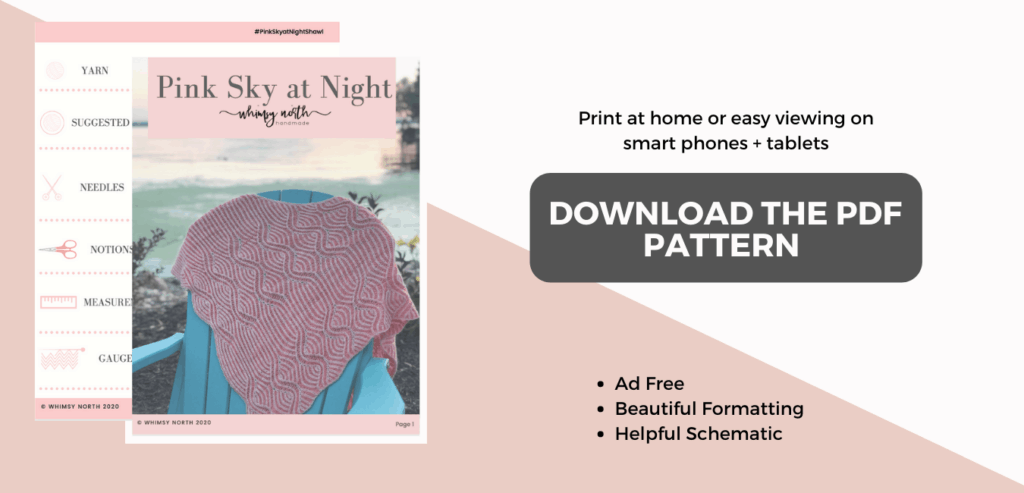
Directions:
SETUP SECTION
With Main Color (MC), CO 5 sts using the Twisted German Cast on. Turn to work CS row.
Setup Row CS MC: {P1, sl1yo} Rep to last st, p1. Slide.
Setup Row CS CC: Join CC yarn, sl1, brk1, sl1yo, brk1, sl1. Turn.
[INC ROW] Row 1 MS MC: K1, sl1yo, br4st inc, sl1yo, k1. Slide. [4 sts inc; 9 sts total]
Row 1 MS CC: Sl1, {brp1, sl1yo} Rep to last 2 sts, brp1, sl1. Turn.
Row 2 CS MC: P1, sl1yo, {brp1, sl1yo} Rep to last st, p1. Slide.
Row 2 CS CC: Sl1, {brk1, sl1yo} Rep to last 2 sts, brk1, sl1. Turn.
[INC ROW] Row 3 MS MC: K1, sl1yo, {brk1, sl1yo} Rep to last 3 sts, brkyobrk, sl1yo, k1. Slide. [2 sts inc]
Row 3 MS CC: Sl1, {brp1, sl1yo} Rep to last 2 sts, brp1, sl1. Turn.
Row 4 CS MC: P1, sl1yo, {brp1, sl1yo} Rep to last st, p1. Slide.
Row 4 CS CC: Sl1, {brk1, sl1yo} Rep to last 2 sts, brk1, sl1. Turn.
Rows 5 – 14 MC & CC: Rep [Rows 3-4 MC & CC] 5 more times. [12 sts inc, 21 sts total]
BRIOCHE WAVES – SECTION ONE
The pattern repeats on the increase rows have been bolded for ease of reading. Make sure to read the notes section regarding stitch counts for this section. The bolded repeats will be partially worked in some rows.
[INC ROW] Row 1 MS MC: K1, sl1yo, *{brk1, sl1yo} 4 times, brRsl dec, sl1yo, brk1, sl1yo, brkyobrk, sl1yo; Rep from * to last 3 sts, brkyobrk, sl1yo, k1. Slide.
Row 1 MS CC: Sl1, {brp1, sl1yo} Rep to last 2 sts, brp1, sl1. Turn.
Row 2 and all even CS MC rows: P1, sl1yo {brp1, sl1yo} Rep to last st, p1. Slide.
Row 2 and all even CS CC rows: Sl1, {brk1, sl1yo} Rep to last 2 sts, brk1, sl1. Turn.
[INC ROW] Row 3 MS MC: K1, sl1yo, *{brk1, sl1yo} 3 times, brRsl dec, sl1yo, brk1, sl1yo, brkyobrk, sl1yo, brk1, sl1yo; Rep from * to last 3 sts, brkyobrk, sl1yo, k1. Slide.
Row 3 MS CC: Sl1, {brp1, sl1yo} Rep to last 2 sts, brp1, sl1. Turn.
[INC ROW] Row 5 MS MC: K1, sl1yo, *{brk1, sl1yo} twice, brRsl dec, sl1yo, brk1, sl1yo, brkyobrk, sl1yo, {brk1, sl1yo} twice; Rep from * to last 3 sts, brkyobrk, sl1yo, k1. Slide.
Row 5 MS CC: Sl1, {brp1, sl1yo} Rep to last 2 sts, brp1, sl1. Turn.
[INC ROW] Row 7 MS MC: K1, sl1yo, *brk1, sl1yo, brRsl dec, sl1yo, brk1, sl1yo, brkyobrk, sl1yo, {brk1, sl1yo} 3 times; Rep from * to last 3 sts, br4st inc, sl1yo, k1. Slide.
Row 7 MS CC: Sl1, {brp1, sl1yo} Rep to last 2 sts, brp1, sl1. Turn.
[INC ROW] Row 9 MS MC: K1, sl1yo, *brRsl dec, sl1yo, brk1, sl1yo, brkyobrk, sl1yo, {brk1, sl1yo} 4 times; Rep from * to last 3 sts, brkyobrk, sl1yo, k1. Slide.
Row 9 MS CC: Sl1, {brp1, sl1yo} Rep to last 2 sts, brp1, sl1. Turn.
[INC ROW] Row 11 MS MC: K1, sl1yo, {brk1, sl1yo} Rep to last 3 sts, brkyobrk, sl1yo, k1. Slide.
Row 11 MS CC: Sl1, {brp1, sl1yo} Rep to last 2 sts, brp1, sl1. Turn.
[INC ROW] Row 13 MS MC: K1, sl1yo, *brkyobrk, sl1yo, brk1, sl1yo, brLsl dec, sl1yo, {brk1, sl1yo} 4 times; Rep from * to last 3 sts, brkyobrk, sl1yo, k1. Slide.
Row 13 MS CC: Sl1, {brp1, sl1yo} Rep to last 2 sts, brp1, sl1. Turn.
[INC ROW] Row 15 MS MC: K1, sl1yo, *brk1, sl1yo, brkyobrk, sl1yo, brk1, sl1yo, brLsl dec, sl1yo, {brk1, sl1yo} 3 times; Rep from * to last 3 sts, brkyobrk, sl1yo, k1. Slide.
Row 15 MS CC: Sl1, {brp1, sl1yo} Rep to last 2 sts, brp1, sl1. Turn.
[INC ROW] Row 17 MS MC: K1, sl1yo, *{brk1, sl1yo} twice, brkyobrk, sl1yo, brk1, sl1yo, brLsl dec, sl1yo, {brk1, sl1yo} twice; Rep from * to last 3 sts, brkyobrk, sl1yo, k1. Slide.
Row 17 MS CC: Sl1, {brp1, sl1yo} Rep to last 2 sts, brp1, sl1. Turn.
[INC ROW] Row 19 MS MC: K1, sl1yo, *{brk1, sl1yo} 3 times, brkyobrk, sl1yo, brk1, sl1yo, brLsl dec, sl1yo, brk1, sl1yo; Rep from * to last 3 sts, brkyobrk, sl1yo, k1. Slide.
Row 19 MS CC: Sl1, {brp1, sl1yo} Rep to last 2 sts, brp1, sl1. Turn.
[INC ROW] Row 21 MS MC: K1, sl1yo, *{brk1, sl1yo} 4 times, brkyobrk, sl1yo, brk1, sl1yo, brLsl dec, sl1yo; Rep from * to last 3 sts, brkyobrk, sl1yo, k1. Slide.
Row 21 MS CC: Sl1, {brp1, sl1yo} Rep to last 2 sts, brp1, sl1. Turn.
[INC ROW] Row 23 MS MC: K1, sl1yo, {brk1, sl1yo} Rep to last 3 sts, brkyobrk, sl1yo, k1. Slide.
Row 23 MS CC: Sl1, {brp1, sl1yo} Rep to last 2 sts, brp1, sl1. Turn.
[24 sts inc, 45 sts total]
Repeat [Rows 1 – 23 MC & CC] 1 more time. St count after repeat [28 sts inc, 73 sts total]
BRIOCHE CALM – SECTION TWO
[INC ROW] Row 1 MS MC: K1, sl1yo, {brk1, sl1yo} Rep to last 3 sts, brkyobrk, sl1yo, k1. Slide.
Row 1 MS CC: Sl1, {brp1, sl1yo} Rep to last 2 sts, brp1, sl1. Turn.
Row 2 CS MC: P1, sl1yo, {brp, sl1yo} Rep to last st, p1. Slide.
Row 2 CS CC: Sl1, {brk1, sl1yo} Rep to last 2 sts, brk1, sl1. Turn.
Rep [Rows 1 & 2 MC & CC] 9 more times. St count after repeats [20 sts inc, 93 sts total]
BRIOCHE WAVES – SECTION THREE
Rep the Brioche Waves Section [Rows 1 – 23 MC & CC] 2 more times. St count after both repeats [50 sts inc, 143 sts total]
BRIOCHE CALM – SECTION FOUR
Rep the Brioche Calm Section [Rows 1 & 2 MC & CC] 10 more times. St count after repeats [20 sts inc, 163 sts total]
BRIOCHE WAVES – SECTION FIVE
Rep the Brioche Waves Section [Rows 1 – 23 MC & CC] 1 more time. Then repeat only [Rows 1 – 12 MC & CC] 1 moretime.
[32 sts inc, 195 sts total]
BIND OFF
Break CC yarn. Using MC, BO all sts using the Elastic Bind Off method as follows: K2, {sl 2 sts purl-wise back to LH needle, k2tog tbl, brk1, sl2 sts purl-wise back to LH needle, k2tog tbl, k2tog tbl, k1} Rep until 3 sts remain, sl2 sts purl-wise back to LH needle, k2tog tbl, k1, sl2 sts purl-wise back to LH needle, k2tog tbl. Break yarn and pull end through the last loop pulling tight to close.
FINISHING
Weave in ends and block your shawl by soaking it in lukewarm water, along with your favorite wool wash, for 15 minutes. Squeeze out excess water with a towel and lay flat to dry. Don’t block on towels as it can retain moisture and not allow your finished shawl to dry. Be careful when blocking brioche as it tends to want to stretch.
Now it’s time to show off your amazing piece of knitted art!
- For more free knitting patterns click here.
- Purchase the ad-free, printable PDF of this pattern here.
- Add this to your Ravelry queue here.
- Pin this to Pinterest for later here.
